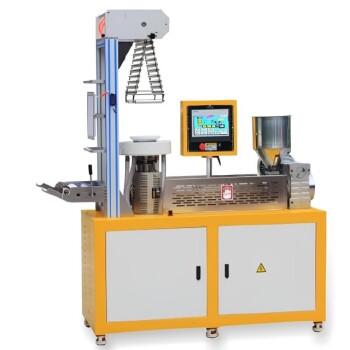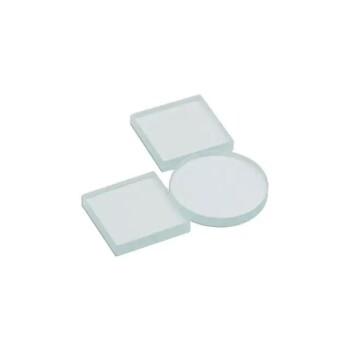Thin Film Deposition Equipment is used in the manufacturing industry to create thin film coatings on substrates. These coatings are used in many opto-electronic, solid-state devices, and medical products. Thin Film Deposition Equipment generally utilizes Physical Vapor Deposition (PVD) or Chemical Vapor Deposition (CVD) techniques. PVD methods include thermal evaporation and sputtering, while CVD methods include plasma-enhanced and low-pressure chemical vapor deposition. Thin Film Deposition Equipment can be used to create coatings that are durable, scratch-resistant, and that can increase or decrease the conductivity of electricity or transmission of signals.
Toggle Categories
Get Instant Support
Choose your preferred way to connect with our team
-
Get Free Quote Fill out form for detailed pricing
-
Send Email Detailed inquiry support
-
WhatsApp Quick mobile chat
Response Time
Within 8 hours on working days, 24 hours on holidays
thin film deposition equipment

Lab Blown Film Extrusion Three Layer Co-Extrusion Film Blowing Machine
Item Number: RPM-05

Tungsten Evaporation Boat for Thin Film Deposition
Item Number: LMF-TEB

Float Soda-Lime Optical Glass for Laboratory Use
Item Number: KTOM-FSO
We have the best Thin Film Deposition Equipment solutions that will exceed your expectations. Our extensive portfolio offers a range of standard solutions to meet your needs, and our bespoke design service allows us to meet almost any customer requirement. Our Thin Film Deposition Sputter systems can be configured with various hardware or software options, including sputter etch or ion source capability for in situ cleaning of substrate surfaces, or substrate preheat stations. Choose us for your Thin Film Deposition Equipment needs.
Applications of Thin Film Deposition Equipment
- Semiconductor manufacturing industry for producing integrated circuits and microprocessors.
- Production of optical devices, such as lenses, mirrors, and filters.
- Solar panel manufacturing for producing thin film solar cells.
- Medical device manufacturing, including surgical instruments and implants.
- Thin film batteries for use in medical products, smart cards, and green energy storage banks.
- Production of fiber lasers, which require thin films for high reflectivity and anti-reflection coatings.
- Thin film transistors for use in liquid crystal displays.
- Manufacturing of LED displays used in consumer electronics.
- Production of magnetic storage devices, such as hard disk drives and magnetic tapes.
- Thin film coatings for improving the wear resistance and corrosion resistance of materials used in aerospace and automotive industries.
Advantages of Thin Film Deposition Equipment
- Improved adhesion, corrosion, and wear resistance of target materials
- Increased durability and longevity of the substrate
- Enables the production of relatively cheap and clean electricity through thin-film solar cells
- Offers aesthetic advantages such as enhancing a substrate's appearance or making it more reflective
- Can deposit a variety of metallic, ceramic, and semiconducting thin films
- Capable of uniformly coating components with complex shapes due to their non-line-of-sight nature
- PVD coatings can be more durable and resistant to corrosion than coatings applied using the electroplating procedure
- Most coatings have exceptional abrasion resistance, high temperature, and good impact strength, and are so long-lasting that protective topcoats are practically never required
- Thin-film batteries are more efficient, charge faster, and last longer compared to conventional Li-ion batteries, improving the performance of medical products, implants, smart cards, and green energy storage banks
- Thin film transistors are inexpensive, energy-efficient, and offer better response time, making them a vital component of liquid crystal displays
- Thin-film technology has countless applications, including semiconductors, medical devices, fiber lasers, LED displays, and other consumer electronics, among others.
Our Thin Film Deposition Equipment offers a cost-effective solution for your laboratory needs. Our equipment line is comprehensive and is designed to fit all your standard requirements. For more unique applications, our custom design service ensures that we cater to your specific needs.
FAQ
What Are The Methods Used To Deposit Thin Films?
What Is Thin Film Deposition Equipment?
What Is Thin-film Deposition Technology?
What Are The Advantages Of Using Thin Film Deposition Equipment?
What Factors Should Be Considered When Selecting Thin Film Deposition Equipment?
What Safety Considerations Are Associated With Operating Thin Film Deposition Equipment?
REQUEST A QUOTE
Our professional team will reply to you within one business day. Please feel free to contact us!
Related Articles

The Architecture of Certainty: Mastering Control in Multifunctional Electrolytic Cells
Precision in electrochemistry isn't about guesswork; it's about hardware architecture. Learn how the three-electrode system isolates variables for true control.

The Silent Partner: Why Material Choice in Electrochemistry is a Matter of Trust
Discover why high borosilicate glass and PTFE are the non-negotiable standards for electrolytic cells. A deep dive into material science for precise data.

How to Choose Crucible Materials That Prevent Chemical Degradation in Vacuum Induction Melting
Learn how to choose crucible materials for vacuum induction melting to prevent chemical degradation and optimize alloy purity. Essential guide for industrial applications.

How ULT Freezers Protect Scientific Discoveries in Genetics and Drug Development
ULT freezers safeguard genetic and pharmaceutical research by maintaining -80°C storage for DNA, proteins, and cell lines—preventing sample degradation and ensuring research validity.

Preserving the Irreplaceable: How ULT Freezers Protect Critical Samples Across Industries
ULT freezers at -80°C protect biological samples, vaccines, and research materials from degradation, ensuring long-term viability across industries.

PTFE gasket: an all-around solution for flange sealing
Polytetrafluoroethylene (PTFE) gaskets have become an ideal choice in the field of flange sealing due to their unique chemical stability and high temperature resistance.

Application of Low-Temperature Pulverization Technology in the Spice Industry
Explores the benefits of low-temperature pulverization for maintaining spice quality and efficiency.

10 Common Dry Ultrafine Crushing Processes
Overview of various dry ultrafine crushing methods and their components.

Techniques and Methods of Freeze Pulverization for Powdered Rubber
An overview of various methods for producing powdered rubber through freeze pulverization, including liquid nitrogen and air turbine expander cold methods.

Common Optical Materials and Their Properties
An overview of various optical materials, their properties, and applications across different spectral ranges.

Understanding Fused Silica: Properties, Applications, and Advantages
An in-depth look at fused silica, its unique properties, and its diverse applications in various industries.

Comprehensive Overview of Fused Silica: Properties, Production, Applications, and Market Prospects
An in-depth exploration of fused silica, its properties, production process, diverse applications, and promising market outlook.

The Rise of Glass Substrates in Advanced Semiconductor Packaging
Explores the shift towards glass substrates in advanced semiconductor packaging, their advantages, and challenges.

Crucible Types, Properties, and Applications
A detailed overview of various crucible types, their properties, and application areas in laboratory and industrial settings.

Electron Beam Evaporation Coating Technology and Material Selection
An in-depth look at the principles and applications of electron beam evaporation coating technology, including material selection and various fields of application.

Electron Beam Evaporation: Advanced Thin Film Creation
Explores the technology and applications of electron beam evaporation in thin film production.

Electron Beam Evaporation Coating: Principles, Characteristics, and Applications
An in-depth analysis of electron beam evaporation coating technology, its advantages, disadvantages, and applications in thin film manufacturing.

Electron Beam Evaporation Technology in Vacuum Coating
An in-depth look at electron beam evaporation, its types, advantages, and disadvantages in vacuum coating processes.

Comprehensive Overview of Vacuum Evaporation Systems
An in-depth look at vacuum evaporation systems, their principles, components, and applications.

Understanding Evaporation Plating, Sputtering Plating, and Ion Plating
A detailed comparison of evaporation plating, sputtering plating, and ion plating techniques, their principles, types, and characteristics.


